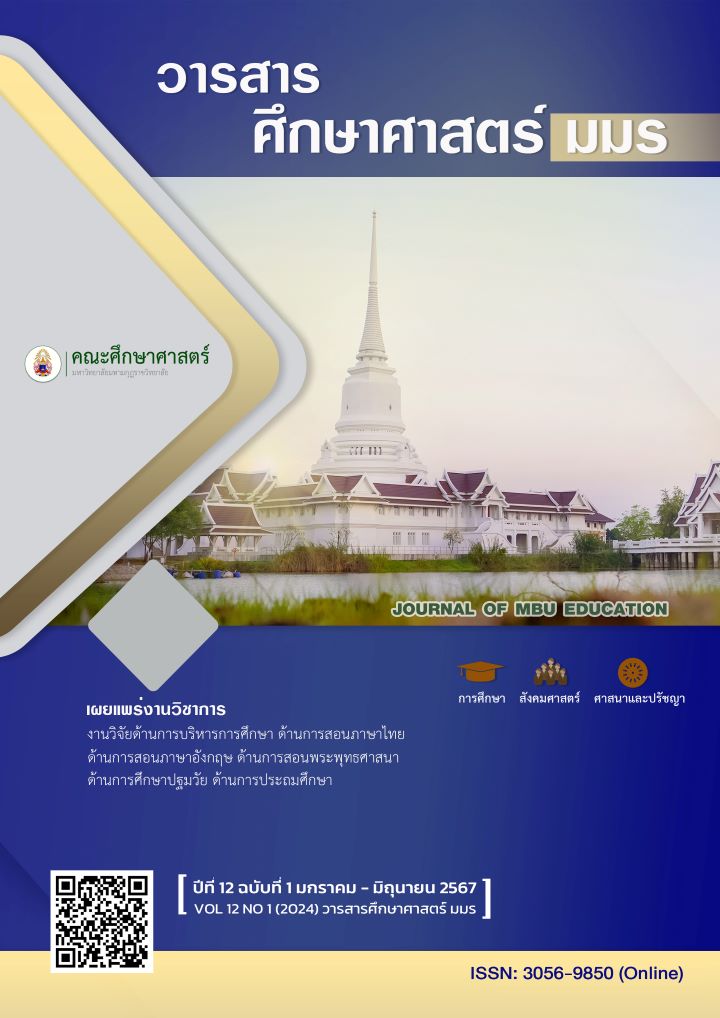Development of Critical Thinking Abilities on Linear Equation in One Variable through Learning Activities Focused on DAPIC Organizing and Think Pair Share for Grade 7 Student
Keywords:
DAPIC concept with Think Pair Share, Critical thinking ability, Linear Equation for One VariableAbstract
This research The objectives of this study were to study the approaches for organizing learning activities based on the DAPIC concept together with the Think Pair Share technique to promote critical thinking ability on single variable linear equations. and to study the ability to think critically about linear equations in one variable after learning activities Participants were 15 Mathayomsuksa 1 students. The researcher used the action research model for 4 action cycles. The research tools were learning activity plans. Model reflecting the results of learning management and a test to measure the ability to think critically. Data were analyzed using content analysis. and check triangular data. The results showed that management of learning in this way There are issues that should be emphasized, such as designing everyday problem situations to suit the age of the students. and encourage students to have a variety of alternative methods or concepts to make decisions that foster critical thinking abilities. Review of basic knowledge necessary to solve problems in situations and encouraging students to participate in activities and expressing their opinions rationally in class. In addition, it was found that after completing all 4 learning cycles, most students had critical thinking abilities in the high level When considering each area of ability, it was found that most of the students had the ability to specify preliminary agreements. and interpretation at the highest level for the ability to infer, a priori, and evaluate arguments at a high level.
References
กระทรวงศึกษาธิการ. (2552). ตัวชี้วัดและสาระการเรียนรู้แกนกลางกลุ่มสาระการเรียนรู้คณิตศาสตร์ตามหลักสูตร แกนกลางการศึกษาขั้นพื้นฐาน พุทธศักราช 2551. กรุงเทพฯ: โรงพิมพ์ชุมนุมสหกรณ์การเกษตรแห่งประเทศไทย.
กรมวิชาการ. (2544). การแก้ปัญหาคณิตศาสตร์. กรุงเทพฯ: โรงพิมพ์คุรุสภาลาดพร้าว.
ชรินทร์ สงสกุล. (2559). การพัฒนาความสามารถในการแก้ปัญหาทางคณิตศาสตร์ของนักเรียนชั้นมัธยมศึกษาปีที่ 3 โดยใช้กระบวนการจัดการเรียนรู้แบบใช้ปัญหาเป็นฐานร่วมกับเทคนิคเพื่อนคู่คิด (วิทยานิพนธ์ปริญญามหาบัณฑิต, มหาวิทยาลัยราชภัฏนครปฐม). ThaiLIS. https://tdc.thailis.or.th/tdc/search_result.php
ญาสุมิน สุวรรณไตรย์. (2563). การพัฒนาความสามารถในการแก้ปัญหาทางคณิตศาสตร์และผลสัมฤทธิ์ทางการเรียน เรื่อง ฟังก์ชันลอการิทึมของนักเรียนชั้นมัธยมศึกษาปีที่ 4 โดยใช้การจัดกิจกรรมการเรียนรู้ตามแนวคิด DAPIC (วิทยานิพนธ์ปริญญามหาบัณฑิต, มหาวิทยาลัยมหาสารคาม). ThaiLIS. https://tdc.thailis.or.th/tdc/search_result.php
วัชรพล จันทรวงศ์. (2562). ผลการจัดการเรียนรู้แบบสืบเสาะหาความรู้ร่วมกับกระบวนการแก้ปัญหาแบบ DAPIC ที่มีต่อความสามารถในการคิดอย่างมีวิจารณญาณของนักเรียนระดับชั้นมัธยมศึกษาปีที่ 4 (วิทยานิพนธ์ปริญญามหาบัณฑิต, มหาวิทยาลัยศรีนครินทรวิโรฒ). ThaiLIS. https://tdc.thailis.or.th/tdc/search_result.php
สุรชัย วงศ์จันเสือ. (2555). การพัฒนาความสามารถในการแก้ปัญหาทางคณิตศาสตร์และความสามารถในการคิดอย่างมีวิจารณญาณ โดยใช้การจัดกิจกรรมการเรียนรู้ตามแนวคิด DAPIC และ CGI ของนักเรียนมัธยมศึกษาปีที่ 3 (วิทยานิพนธ์ปริญญามหาบัณฑิต, จุฬาลงกรณ์มหาวิทยาลัย). ThaiLIS. https://tdc.thailis.or.th/tdc/search_result.php
ปิยวรรณ ผลรัตน์. (2560). การพัฒนาความสามารถในการแก้ปัญหาทางคณิตศาสตร์และผลสัมฤทธิ์ทางการเรียน คณิตศาสตร์ของนักเรียนชั้นมัธยมศึกษาปีที่ 3 เรื่อง อสมการ โดยใช้รูปแบบ SSCS ร่วมกับเทคนิคเพื่อนคู่คิดความสามารถในการคิด (วิทยานิพนธ์ปริญญาวิทยาศาสตรมหาบัณฑิต, มหาวิทยาลัยเทคโนโลยีพระจอมเกล้าธนบุรี). ThaiLIS. https://tdc.thailis.or.th/tdc/search_result.php
สหพงศ จั่นศิริ. (2562). การพัฒนาทักษะการคิดอย่างมีวิจารณญาณ โดยใช้การจัดการเรียนรู้แบบปัญหาเป็นฐาน ในรายวิชาหลักการจัดการฟาร์ม สำหรับนักเรียนระดับประกาศนียบัตรวิชาชีพ ชั้นปีที่ 2 (วิทยานิพนธ์ปริญญามหาบัณฑิต, มหาวิทยาลัยธุรกิจบัณฑิตย์). ThaiLIS. https://tdc.thailis.or.th/tdc/search_result.php
เบญญาภา ราชพัฒน์. (2561). การศึกษาการแก้ปัญหาทางคณิตศาสตร์ ของนักเรียนชั้นมัธยมศึกษาปีที่ 2 ที่มีระดับการคิดอย่างมีวิจารณญาณและเพศแตกต่างกัน (วิทยานิพนธ์ปริญญามหาบัณฑิต, มหาวิทยาลัยราชภัฏมหาสารคาม). ThaiLIS. https://tdc.thailis.or.th/tdc/search_result.php
Byerley, R. Aaron. (2001). Using Multimedia and "Active Learning" Techniques to"Energize " An introductory Engineering Thermodynamics Class. Frontier in EducationConference, 2002.
Ika Putri Wulandari, Rochmad Rochmad & Sugianto Sugianto (2019). Critical Thinking Ability in terms of Adversity Quotient on DAPIC Problem Solving Learning. Retrieved August 5, 2022, from https://journal.unnes.ac.id/sju/index.php/ujmer/article/view/30421
Ika Putri Wulandari, Rochmad Rochmad & Sugianto Sugianto (2020). Integrated Between DAPIC Problem Solving Model and RME Approach to Enhance Critical Thinking Ability and Self Confidence. Retrieved August 5, 2022, from https://eric.ed.gov/?id=EJ1269830
Karnjanarukpong, S. (2004). 29 Techniques for organizing a variety of learning activities:cooperative learning. Bangkok: Tarn Aksorn. (in Thai)
Lyman, F.T. (1981). The responsive classroom discussion. In A. S. Anderson (Ed.), Mainstreamong digest. College Park: University of Maryland College of Education. Retrieved July 23, 2022, from http://rightsstatements.org/page/InC/1.0/?language=en.



